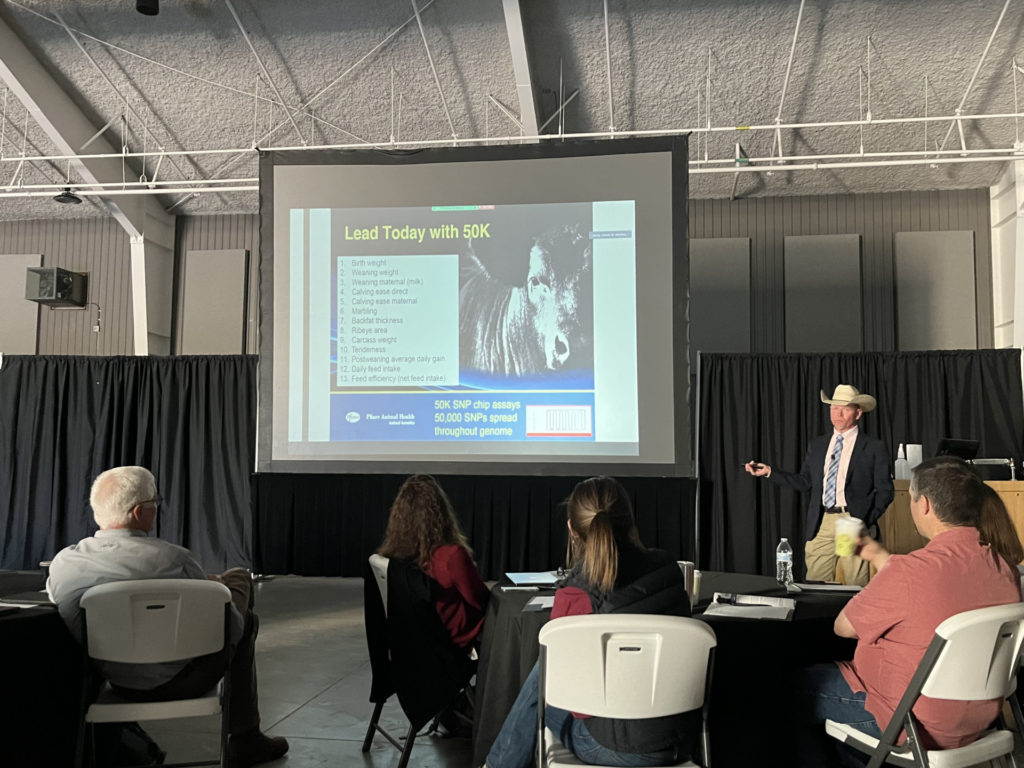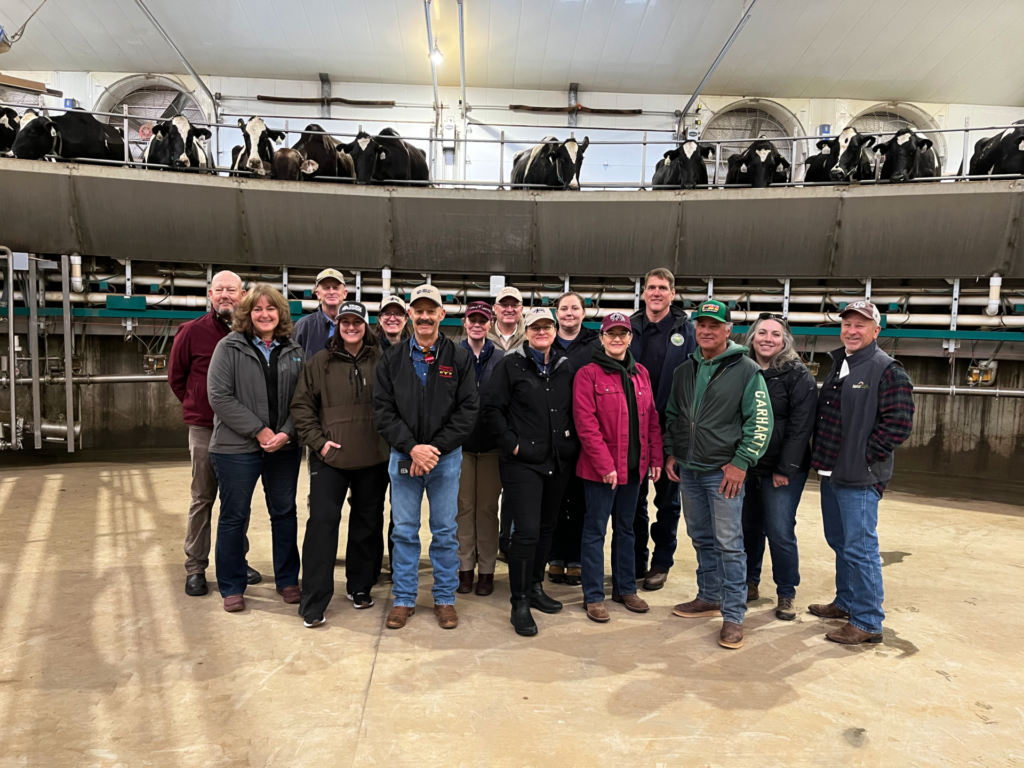New agribusiness course brings together cattle industry, animal health officials
Focus is agribusiness operational concerns, business continuity in context of animal disease outbreak
A new Texas A&M AgriLife course hosted by the Institute for Infectious Animal Diseases, IIAD, is providing executive-level state animal health officials, SAHOs, with important insights into the business of the cattle industry so they may better understand the full impact of responding to an animal disease outbreak.

IIAD is part of the Texas A&M University System and Texas A&M AgriLife Research.
“This course is a one-week, in-person and hands-on training opportunity for SAHOs from throughout the country to learn the agribusiness realities facing the U.S. commercial cattle feeding and dairy industries,” said Dee Ellis, DVM, Ph.D., an AgriLife Research veterinarian in the Department of Entomology in Texas A&M’s College of Agriculture and Life Sciences.
Ellis was the primary developer of the Cattle Agribusiness Course, funded by the U.S. Department of Agriculture’s Animal and Plant Health Inspection Service, APHIS, through the National Animal Disease Preparedness and Response Program. Ellis said those who will benefit from the course include state, assistant state and field veterinarians, veterinary program managers, field epidemiologists, agribusiness industry specialists and consultants, and regulatory and quality control professionals.
“The Cattle Agribusiness Course Dr. Ellis has developed is unique in that it provides the opportunity for animal health officials, academics and those in the cattle and dairy industry to learn from one another and get a better understanding of one another’s roles and challenges,” said Heather Simmons, DVM, veterinary project director and IIAD director. “It also gives participants a firsthand look at the size, capabilities and concerns of the U.S. cattle industry agribusiness to promote collaboration and cooperation in an animal disease outbreak.”
Course faculty represent the Texas and U.S. cattle feeder and dairy industries, as well as Texas A&M and AgriLife Research. Other Texas A&M entities providing course input include the IIAD, Texas A&M College of Veterinary Medicine and Biomedical Sciences, West Texas A&M University and the Texas A&M Veterinary Education, Research and Outreach Program, also known as VERO.
Purpose of the course
Ellis said the purpose of the course is to provide specialized educational opportunities for SAHOs regarding the agribusiness functions of the U.S. cattle feeding and dairy industries that might be impacted during a foreign animal disease, or FAD, response.
“Industry speakers are utilized as much as possible, and all site visits include fully operational cattle facilities,” Ellis said.

Topics covered in the course include basic overviews of the industries, business and marketing principles utilized to make the industries viable, as well as an introduction to animal health, environmental, nutritional, marketing and biosecurity principles.
“By understanding the business model of the industries they regulate, the SAHOs will be in a better position to effectively communicate with and support those same industries and their stakeholders in the face of an animal disaster or infectious disease outbreak situation,” he said.
Improving agribusiness knowledge
“The camaraderie between regulatory and industry entities is crucial for sustaining our country’s agriculture, and the agribusiness course supports this initiative,” said Sarah Manning, AgriLife Research program coordinator with IIAD.
Manning said by participating in this course, SAHOs learned the daily operations and business principles within the beef and dairy industry and how they, state animal health officials, can implement realistic disease-mitigation strategies and procedures with as little disruption to the industry as possible.
“The course also provided regulatory officials with the realities of the agribusiness industry and showed them what works on paper doesn’t always work in practical application,” she said.
Pilot course industry response
“We were pleased to be involved in the design and execution of these two pilot courses that allowed us to bring state animal health officials to Texas from throughout the U.S.,” said Ben Weinheimer, president and CEO of the Texas Cattle Feeders Association, Amarillo.

Weinheimer said the curriculum provided a “complete immersion experience of the entire beef supply chain” that participants were unlikely to get anywhere else.
“This was much more impactful than a textbook curriculum,” he said. “Participants were able to see a cow-calf operation, livestock auction, dairy processing facility and beef packing plant firsthand and received instruction from industry and academic experts in specific disciplines.”
He said course discussion included how the type, location and extent of an animal disease outbreak should be considered in a regulatory response and how different steps might be taken in different situations.
“We also discussed how to slow down operations or stop animal movements when needed and how to implement enhanced biosecurity protocols outlined in secure beef supply plans to minimize the amount time for supply chain links to resume normal operations,” Weinheimer said.
Weinheimer said he hopes the association can continue to participate in and support the type of professional education provided by the Cattle Agribusiness Course.
“In addition to state animal health officials, this course would be beneficial for those in other state and federal government agencies, emergency management personnel and others with a role in responding to an animal disease outbreak,” he said.
Darren Turley, executive director of the Texas Association of Dairymen, said he was glad his association could help provide course participants insights into the state’s dairy industry.
“Most people do not have a very good understanding of the role and operation of large agriculture, including the dairy industry,” Turley said. “It was gratifying that we could bring in these animal health officials from other states to see the actual extent of large animal farm operation and the biosecurity measures already in place.”
He also noted that it was important that participants see the role and breadth of large agriculture in the High Plains area of Texas.
“Other states have dairy, but the conditions and supply chain issues are different in different states, so I’m glad they got to see what the dairy industry in this part of the country is really like and see some of the advances we’ve made and how we’ve evolved and modernized.”
He said he felt the course allowed everyone involved to get a better perspective on one another’s regulatory and safety concerns.
“In particular, I think participants gained an understanding of how the industry here is addressing biosecurity,” he said. “The class is an excellent idea, and I hope even more people in the dairy and beef cattle industry and affiliated agribusinesses will take the opportunity to participate in this course sometime in the future.”
Pilot course participant response
“We have already presented two of these beef agribusiness courses as pilot courses this year, one in March and one in April, and the participant feedback we have received has been excellent,” Ellis said.
The pilot courses presented in March and April took place in the Texas High Plains. Each course hosted a group of 10 SAHOs who experienced tours of a feed yard, milking dairy, calf ranch, livestock market, milk processing plant and a beef packing plant.
Scott Leibsle, DVM, state veterinarian of Idaho, was one of the participants in that pilot course.
“In our position as regulators, we often get siloed and distanced from some aspects of the various cattle industries that don’t require significant regulatory oversight,” he said. “This can lead to a lack of understanding that could adversely influence the decision-making process in other aspects of the industry, especially the commercial side.”
Leibsle said for him the most beneficial part of the course was the beef program, especially the opportunities to visit ranches and feedlots where he could learn more about beef genetics, nutrition, processing and other aspects of the industry.
“The course gave me better insight into the impact that regulatory decisions can have upon the cattle industry as a whole, as well as where government and industry can work together to solve problems,” he said. “It really gave me a great overview of the infrastructure of the beef industry to allow me, for example, to better help Idaho cattle producers prepare for a potential livestock disease outbreak. The reason state veterinarians are in the role they are in is to help make decisions that will allow business and commerce to continue in the face of a disease outbreak, while at the same time minimizing the risk of disease transmission.”
Leibsle said he thought the course should be required for all state animal health officials, especially new graduates that have not yet had the benefit and experience of multiple years in practice.
. “The open discussions that were held between industry and regulatory officials of the challenges and concerns in the beef and dairy business during this course were invaluable and by far the highlight of the course,” he said.
Kristin Haas, DVM, Vermont state veterinarian, was also a pilot program participant.
“The Beef Agribusiness Course was easily one of the best trainings I’ve been through in my 14 years as a state animal health official,” Haas said. “The ability to have direct contact with business owners in each link of the beef cattle chain and dairy industry greatly improved my understanding of the real-life factors relating to agribusiness that need to be considered when addressing an animal disease outbreak.”
She said too often, SAHOs do not have the opportunity to get broad input from those in the very industries they are supposed to help protect and support.

“Having this input and understanding their perspective helped me better understand the nature of the speed of commerce in the dairy and beef cattle value chain,” she said. “It showed me the complexity of these networks and reinforced that a disease response must take them into account when policy decisions are being made.”
Haas said the course organizers, instructors, presenters and trainers were excellent and brought real-life context to many complex issues. She said one of the main lessons reinforced throughout the course was the need to keep agribusinesses viable while also managing animal disease outbreaks.
“I’ve recently had a chance to share what I learned in the course with animal agriculture colleagues in the New England area,” she said.
Haas said one of the more important lessons she learned during the course was that due to the 24/7 nature of agribusiness and the speed of commerce, even a small disruption could have an amplified negative effect on an agribusiness operation.
“In these operations, there are usually no holidays or downtime, and being aware of this will help us better understand them and collaborate with other regulators to make decisions that are supportive of these industries and that don’t inadvertently create additional challenges for them,” she said
Developing a new course
Ellis said Texas A&M also recently received funding for a similar commercial poultry agribusiness course set to take place this fall.
“Agribusiness in the poultry industry is also subject to potential operational disruption from the outbreak of various avian diseases, including the most current example – the highly pathogenic avian influenza,” he said. “We have received funding to develop a course that will help state animal health officials better understand this important industry and hope to have it ready by the fall, depending on what transpires in the industry.”




